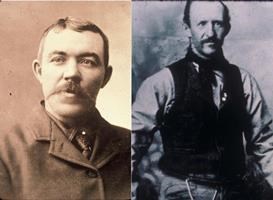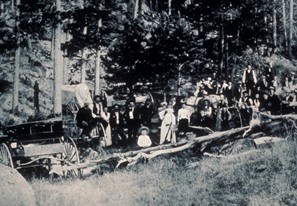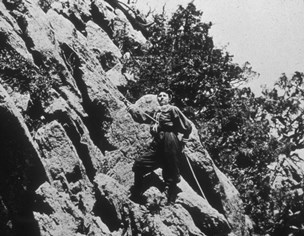
NPS archives In 1890, a local rancher named Bill Rogers boasted to his brother-in-law, "I'll be on top of the Tower before three years." Like most people with good sense, his brother thought Rogers sure to meet his demise in the undertaking. Rogers, however, was not to be underestimated. Forming an IdeaThe early 1890s saw an economic downturn for the ranching industry. Bill Rogers and his new business partner, Willard Ripley, would talk about Rogers' idea of climbing Devils Tower. They felt that an accomplishment like this could surely draw a crowd and make them some money. Ripley's father supported the idea, and the three men worked to formulate a plan for making it to the summit. In 1893, they were attempting to fly a large kite over the top of the Tower; the idea was to use the kite string to haul a rope over the Tower to aid their climb. When the kite became stuck in one of the Tower's cracks, a new plan had to be formed. While they were attempting to dislodge their kite, Rogers and Ripley noticed the crack it was stuck in seemed to go from the base of the Tower clear to the top. This crack was to be their path to the summit. 
NPS Photo ConstructionThe two men, with the help of Ripley's father, began cutting logs for what would become a 350-foot ladder. Rogers and the elder Ripley did most of the cutting and hauling, while Ripley did the bulk of the construction. They cut large pegs, about three inches in diameter, 24-30 inches long and sharpened on one end. Ripley would hammer the sharp end into the crack, connecting the outside with boards. Work continued for several months, with Ripley inching his way up the Tower. The left-handed rancher had the advantage over his partner, since he was able to better position himself for use of his dominant hand. A pulley system brought up the raw materials as Ripley stood on his newly inserted rungs.
The crack (and ladder) did not go to the summit. Built into the southeast face of the Tower, it reached a sloped area about two-thirds of the way up known today as "the Meadows." From there, Ripley was able to scramble up to the actual summit. Construction was completed on June 28 or 29 of 1893, and Rogers was already making preparations for hosting a spectacle. Ripley finished the ladder and scrambled to the summit; when he came down he told his wife "there was nothing on top of the Tower but a little soil and some sagebrush" - a very anticlimactic statement from a man who had just accomplished what many viewed as impossible! Planning a Grand EventAs Ripley finished the stake ladder, Rogers was busy spreading the word about a 4th of July event at Devils Tower. A handbill for the occasion was distributed throughout the region. It boasted of special speakers, food and drink for sale, hay for horses and lots of dancing. The highlight of the day would be the ascent of the new ladder, with Rogers planting the American flag ("Old Glory") on the Tower's summit. Linnie Rogers and Dollie Ripley, the wives of the two ranchers, would organize and sell the food, drink and livestock accomodations. The handbill boasted: "Perfect order will be maintained. The rarest sight of a life time will be observed, and the 4th of July will be better spent at the Devil's Tower than at the World's Fair." 
Making History, Making TraditionsSpectators came from as far away as Rapid City, South Dakota. Some journeyed over 100 miles - a 3-day trip by horse and wagon - to watch the two men climb "the Devils' Tower." By the evening of July 3rd, an estimated 800 people were camped along the Belle Fourche River at the base of the Tower. In a region thinly settled, a crowd that size was a sight to behold. But the sight they all came to see occured the following day. Before his climb, Bill Rogers donned an Uncle Sam suit and received a flag to carry with him. By noon he was on the top with the American flag snapping in the stiff Wyoming wind. After he made his descent, the crowd cheered for his victorious feat, and celebrations continued through the night. Accounts of the day included several other people who may have climbed the Tower - spectators from the crowd. A long-held belief that the flag was torn up and sold in pieces was never substantiated (local historians have never located any of the pieces). What is known is the yearly tradition that grew out of this first historic event. 
NPS archives Old Settlers and New DaredevilsAlthough not officially organized until 1932, people congregated at the Tower every summer around the 4th of July. These gatherings would come to be known as the "Old Settlers' Picnics." The big event hosted by Rogers and Ripley was the first well-known gathering, and the ladder became a focus for many years thereafter. Using the same ladder her husband used two years previous, Linnie Rogers became the first woman to climb the Tower on July 4, 1895. Reportedly, parts of the ladder were removed or destroyed to prevent people from attempting the dangerous climb. The last known use of the ladder was in 1927 by daredevil Babe "The Fly" White. In 1972, the park service removed what was left of the bottom section, and restored the top 140 feet of the ladder. It remains today as part of the cultural history of Devils Tower National Monument. |
Last updated: April 24, 2025
